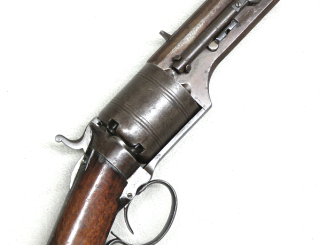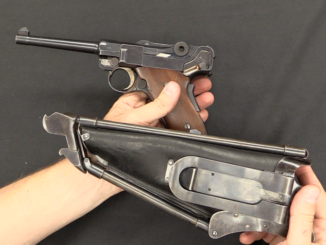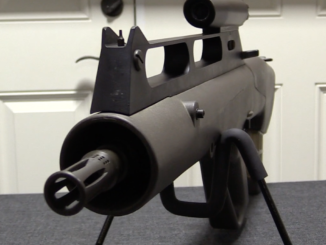Charles H. Ballard is much better known for his single shot rifle design, but he also designed, patented, and produced a .41 rimfire caliber derringer. These were popular concealed weapons during the 19th century, and remain in production even today (though no longer in .41 rimfire…). Production began circa 1870, and a few thousand of Ballard’s derringers were made.
Related Articles

Antiques
Military-Issue Colt Model 1839 Paterson Revolving Rifle
The first rifle made in Sam Colt’s Paterson NJ factory was the 1837 “ring lever” rifle. These were rather fragile and underpowered and while they were used successfully in the First Seminole War, they needed […]

Accessories
“Ideal” Holster/Stock for the Luger
Stock Pistol Most automatic pistols of the early 20th century were offered with shoulder stock options, and the Luger had more than most. Probably the most interesting one I am aware of is the Ideal […]

bullpup
Steyr ACR: A Polymer Flechette-Firing Bullpup From the 90s
The US Army ACR (Advanced Combat Rifle) program was an effort to find a new type of infantry rifle which could increase the practical accuracy of the M16 by a whopping 100% in the […]

When I first saw it, not knowing its dimensions, I thought it looked like a typical “Very” (flare) pistol of the WW1 era.
Seeing its internal functions, it looks even more like a “flare gun”.
I believe the parallels between “Derringer” design and “Very pistol” design are an as-yet unexplored area of firearms history.
clear ether
eon
https://www.thehenryford.org/explore/blog/a-signal-success-the-barrier-breaking-story-of-martha-coston claims that
The U.S. Navy showed high interest in Martha’s invention, but stalled the purchase of the patent until 1861, after the Civil War erupted. With a blockade of Southern ports in place, the Navy needed Martha’s flares to communicate. Her business, the Coston Manufacturing Company, produced the flares and sold them at cost for the duration of the war. New York gun manufacturer William Marston produced the signal pistol above to exclusively fire Coston’s multicolored signal flare.
So maybe you should investigate 1860s fire-arm manufacturer with name Marston.
The thing is, the “Coston light” was not “fired”. The pistol-like device was just to hold it and ignite it via a single-action trigger tripping a hammer, which hit a percussion cap (Maynard “tape cap” type) built into the base of the cylindrical paper “light cartridge” stuck into the “muzzle” of the gadget.
Then the signaler held it at arm’s length, straight up over his head, until it burned down like a 4th of July “sparkler”. Except burning much hotter to ensure that it was bright enough to to be seen in daylight, and taking about two minutes to burn rather than thirty seconds.
It also meant the signalman would be showered with hot sparks, as well as being a wonderful target for every Johnny Reb rifleman in the township, especially any sniper with a telescope-sighted “heavy”.
The “Coston light” was in every signal unit’s tool box, and was probably the most-disliked and least-used piece of equipment in their inventory for obvious reasons.
Actual flare pistols came along much later. Edward Wilson Very’s patent for a “new and useful improvement in Pyrotechnic signal cartridges…”, US Patent 190263, is dated 1 May 1877.
https://web.archive.org/web/20070427194939/http://www.diggerhistory.info/pages-weapons/signal-pistols.htm
And as can be seen here, the first “Very pistols” looked and functioned remarkably like Derringers.
“Very” big Derringers.
cheers
eon
Nice video Ian!
Concerning “…they were getting muzzle velocities of 500, maybe 550, feet per second and that’s not really anything to scoff at”
Brendan Michael Murphy’s book “The 41 Short Rim-Fire: Deadliest Round in the West” (ISBN 978-1-5323-4084-0) seeks to rehabilitate this ammunition on the basis of his detailed study of the tighter bores and compressed black powder loadings of the late 19th century guns and ammo when both would have been new and therefore in good condition.
His average findings were 575 to 625 FPS average for pre 1900 black powder loads (from a variety of short barrelled derringer pistols) compared to 600 to 650 FPS for post 1900 smokeless loads (from Model 95 Remington Double Derringers of about 1912 vintage).
He comments that “Performance from antique .41 Rim-fire revolvers of that early black powder period would exceed these ratings since many of them had also significantly undersized bores designed by the manufacturers … to obtain a maximum safe pressure spike …”
He counsels against trying to load hot for any antique guns!
It seems the 41 Short RF was not going to “bounce off saloon bar bottles” as some have suggested.
“(…)some have suggested.”
https://web.archive.org/web/20160502110215/http://gunsmagazine.com/henry-deringers-pocket-pistol/ has following measurement of modern loading
From the 3-inch barrels of a Remington, the Western Lubaloys averaged 532 fps and the new lot of Navy Arms ammunition, 621 fps.
which is mutually exclusive with suggestion of
Frank Barnes’ invaluable reference, Cartridges of the World, has this to say about it: “The .41 Rimfire Short is so underpowered as to be worthless for anything but rats, mice or sparrows at short range. Fired from the average derringer at a tree or hard object 15 to 25 yards away, the bullet will often bounce back and land at your feet.”
Murphy describes his technique of removing the bullet from Navy Arms smokeless .41 Sort RF ammo and then compressing the black powder and reseating with a correctly sized bullet (even with the safety precautions he adopted) as “somewhat of a risky endeavour”
Not recommended
If somebody wants a usable Remington Double Derringer today, Bond Arms has them covered.
https://www.bondarms.com/bond-arms-handguns/
The “Stinger” that can chamber and fire .380 ACP, 9 x 19mm, and/or .38 Special is probably the most all-around useful model. You can “acquire” ammunition to fit it almost anywhere on Earth.
clear ether
eon
Since muzzle energy varies with the square of the velocity the change from 425 fps quoted by some sources to a measured 650 fps more than doubles the m/e which brings the .41 short rf closer to some 32 ACP ammo than to most 25 ACP. Wouldn’t want to be on the receiving end of any of them.
Discussing the relative energies, muzzle velocities, bullet weights, and so on for these old pistol cartridges is entertaining, but misses the point of such small, concealable handguns, no matter they be .22 Short or .44 Colt, and that is that it didn’t MATTER how big or fast the bullet fired was, only that it could penetrate skin–which doesn’t take very much, something like 250fps and 16 grains for a .177″ round projectile.
If a bullet could puncture the skin, and maybe a fair amount of ‘meat,’ that meant that the bullet also carried with it deep into the wound the grease on its base, the pocket lint from its barrel, the soiled clothing, and the unwashed skin of the person shot–a perfect recipe for a major infection, followed by sepsis, followed by death. In an era without antiseptics, any thought of wound cleanliness, irregular bathing and clothing worn for days, if not weeks or months, ANY hole in the skin, especially a deep hole with a dirty bullet at the end of it, could very likely be fatal; More so a wound in the torso, where the important bits reside. For that reason, people of the past knew very well that getting shot with ANYthing was very possibly going to kill them, slowly, and took even the smallest pistols seriously. If we didn’t have the modern advantages of antiseptics, proper wound care, and rapid access to trauma surgeons and ERs, many more ‘minor’ gunshot wounds would be fatal.
So true. The most celebrated death from .41 short rimfire (the financier Jim Fisk who was killed with a 3″ barrelled Colt House pistol in 1872) took well over 12 hours to succumb to one shot to the abdomen and one to the upper arm. After three trials his killer, Edward Stokes, was eventually convicted of manslaughter. Much was made of the poor treatment given to Fisk by his medics.
There was, also, no hesitation about shooting a human head, or contact shooting. I have seen any number of woodcut prints of altercations with one party pressing his muzzle to the skull or neck of an enemy.